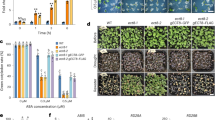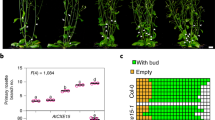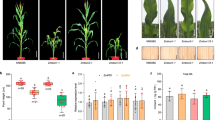Abstract
Protein farnesylation is a post-translational modification involving the addition of a 15-carbon farnesyl isoprenoid to the carboxy terminus of select proteins1–3. Although the roles of this lipid modification are clear in both fungal and animal signalling, many of the mechanistic functions of farnesylation in plant signalling are still unknown. Here, we show that CYP85A2, the cytochrome P450 enzyme that performs the last step in brassinosteroid biosynthesis (conversion of castasterone to brassinolide)4, must be farnesylated to function in Arabidopsis. Loss of either CYP85A2 or CYP85A2 farnesylation results in reduced brassinolide accumulation and increased plant responsiveness to the hormone abscisic acid (ABA) and overall drought tolerance, explaining previous observations5. This result not only directly links farnesylation to brassinosteroid biosynthesis but also suggests new strategies to maintain crop yield under challenging climatic conditions.
This is a preview of subscription content, access via your institution
Access options
Subscribe to this journal
Receive 12 digital issues and online access to articles
$119.00 per year
only $9.92 per issue
Buy this article
- Purchase on Springer Link
- Instant access to full article PDF
Prices may be subject to local taxes which are calculated during checkout




Similar content being viewed by others
References
Andrews, M., Huizinga, D. H. & Crowell, D. N. The CaaX specificities of Arabidopsis protein prenyltransferases explain era1 and ggb phenotypes. BMC Plant Biol. 10, 118 (2010).
Reiss, Y., Stradley, S. J., Gierasch, L. M., Brown, M. S. & Goldstein, J. L. Sequence requirement for peptide recognition by rat brain p21ras protein farnesyltransferase. Proc. Natl Acad. Sci. USA 88, 732–736 (1991).
Running, M. P. The role of lipid post-translational modification in plant developmental processes. Front. Plant Sci. 5, 50 (2014).
Kim, T.-W. et al. Arabidopsis CYP85A2, a cytochrome P450, mediates the Baeyer-Villiger oxidation of castasterone to brassinolide in brassinosteroid biosynthesis. Plant Cell 17, 2397–2412 (2005).
Cutler, S., Ghassemian, M., Bonetta, D., Cooney, S. & McCourt, P. A protein farnesyl transferase involved in abscisic acid signal transduction in Arabidopsis. Science 273, 1239–1241 (1996).
Tang, W. et al. BSKs mediate signal transduction from the receptor kinase BRI1 in Arabidopsis. Science 321, 557–560 (2008).
Ryu, H., Cho, H., Bae, W. & Hwang, I. Control of early seedling development by BES1/TPL/HDA19-mediated epigenetic regulation of ABI3. Nature Commun. 5, 4138 (2014).
Cai, Z. et al. GSK3-like kinases positively modulate abscisic acid signaling through phosphorylating subgroup III SnRK2s in Arabidopsis. Proc. Natl Acad. Sci. USA 111, 9651–9656 (2014).
Steber, C. M. & McCourt, P. A role for brassinosteroids in germination in Arabidopsis. Plant Physiol. 125, 763–769 (2001).
Park, J. W., Reed, J. R., Brignac-Huber, L. M. & Backes, W. L. Cytochrome P450 system proteins reside in different regions of the endoplasmic reticulum. Biochem. J. 464, 241–249 (2014).
Zhang, F. L. & Casey, P. J. Protein prenylation: molecular mechanisms and functional consequences. Annu. Rev. Biochem. 65, 241–269 (1996).
Hancock, J. F., Cadwallader, K., Paterson, H. & Marshall, C. J. A CAAX or a CAAL motif and a second signal are sufficient for plasma membrane targeting of ras proteins. EMBO J. 10, 4033 (1991).
Pfeffer, S. & Aivazian, D. Targeting Rab GTPases to distinct membrane compartments. Nature Rev. Mol. Cell Biol. 5, 886–896 (2004).
Kozuka, T. et al. Involvement of auxin and brassinosteroid in the regulation of petiole elongation under the shade. Plant Physiol. 153, 1608–1618 (2010).
Andersson, M. X., Goksör, M. & Sandelius, A. S. Optical manipulation reveals strong attracting forces at membrane contact sites between endoplasmic reticulum and chloroplasts. J. Biol. Chem. 282, 1170–1174 (2007).
Kagale, S., Divi, U. K., Krochko, J. E., Keller, W. A. & Krishna, P. Brassinosteroid confers tolerance in Arabidopsis thaliana and Brassica napus to a range of abiotic stresses. Planta 225, 353–364 (2007).
Bajguz, A. & Hayat, S. Effects of brassinosteroids on the plant responses to environmental stresses. Plant Physiol. Biochem. 47, 1–8 (2009).
Yuan, G.-F. et al. Effect of brassinosteroids on drought resistance and abscisic acid concentration in tomato under water stress. Sci. Horticult. 126, 103–108 (2010).
Anjum, S. A. et al. Brassinolide application improves the drought tolerance in maize through modulation of enzymatic antioxidants and leaf gas exchange. J. Agron. Crop Sci. 197, 177–185 (2011).
Zhou, J. et al. H2O2 mediates the crosstalk of brassinosteroid and abscisic acid in tomato responses to heat and oxidative stresses. J. Exp. Bot. 65, 4371–4383 (2014).
Rodrigues, A. et al. The short-rooted phenotype of the Brevis radix mutant partly reflects root abscisic acid hypersensitivity. Plant Physiol. 149, 1917–1928 (2009).
Li, Z.-Y. et al. A mutation in Arabidopsis BSK5 encoding a brassinosteroid-signaling kinase protein affects responses to salinity and abscisic acid. Biochem. Biophys. Res. Commun. 426, 522–527 (2012).
Hu, Y. & Yu, D. BRASSINOSTEROID INSENSITIVE2 interacts with ABSCISIC ACID INSENSITIVE5 to mediate the antagonism of brassinosteroids to abscisic acid during seed germination in Arabidopsis. Plant Cell 26, 4394–4408 (2014).
Nomura, T. et al. The last reaction producing brassinolide is catalyzed by cytochrome P-450s, CYP85A3 in tomato and CYP85A2 in Arabidopsis. J. Bio. Chem. 280, 17873–17879 (2005).
Clough, S. J. & Bent, A. F. Floral dip: a simplified method for Agrobacterium-mediated transformation of Arabidopsis thaliana. Plant J. 16, 735–743 (2008).
Acknowledgements
This work was supported by Natural Sciences and Engineering Research Council of Canada funding for P.M. and M.A.S. We thank S. Urquhart (University of Tasmania) for assistance with hormone extraction and D. Nichols and N. Davies (University of Tasmania) for assistance with hormone quantification. We thank D. K. Ro (University of Calgary) for helpful discussions on cytochrome p450 enzymes and their functions.
Author information
Authors and Affiliations
Contributions
J.N., P.M. and M.A.S. initiated the project. J.N., S.L., P.M. and M.A.S. designed the research; J.N., S.L., M.J., S.D. and M.A.S. performed all the experiments; E.F. and J.B.R. undertook brassinosteroid quantifications and analysis; J.N., S.L. and M.A.S. analysed data; and P.M. and M.A.S. wrote the manuscript. All authors discussed the results and commented on the manuscript.
Corresponding authors
Ethics declarations
Competing interests
The authors declare no competing financial interests.
Supplementary information
Supplementary Information
Supplementary Methods, Supplementary References, Supplementary Tables 1-3 and Supplementary Figs 1-7. (PDF 1950 kb)
Rights and permissions
About this article
Cite this article
Northey, J., Liang, S., Jamshed, M. et al. Farnesylation mediates brassinosteroid biosynthesis to regulate abscisic acid responses. Nature Plants 2, 16114 (2016). https://doi.org/10.1038/nplants.2016.114
Received:
Accepted:
Published:
DOI: https://doi.org/10.1038/nplants.2016.114
This article is cited by
-
Plasmodesmata mediate cell-to-cell transport of brassinosteroid hormones
Nature Chemical Biology (2023)
-
Divulging Molecular Perspectives of Plant Defense Machinery Under Heavy Metal Toxicity
Journal of Plant Growth Regulation (2023)
-
Transcriptomic analysis provides insights into the abscisic acid mediates brassinosteroid-induced cold resistance of grapevine (Vitis vinifera L.)
Plant Growth Regulation (2023)
-
The Arabidopsis protein farnesylation era1 mutant displays an altered hormonal-dependent nitrate regulation of root architecture
Plant Growth Regulation (2023)
-
Role of Phytohormones in Regulating Heat Stress Acclimation in Agricultural Crops
Journal of Plant Growth Regulation (2022)



